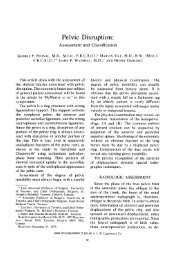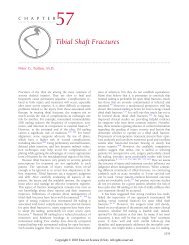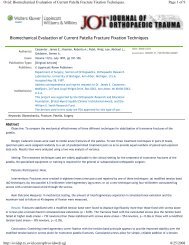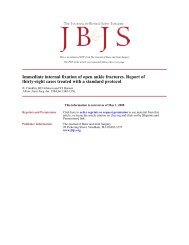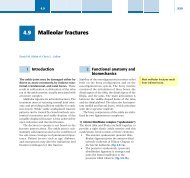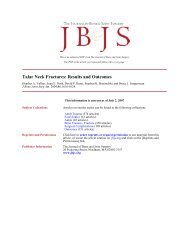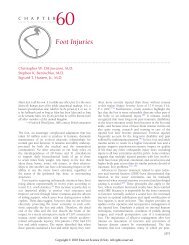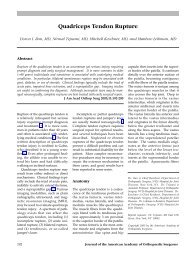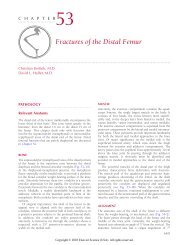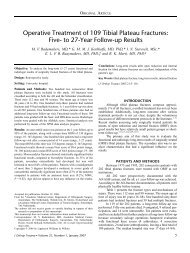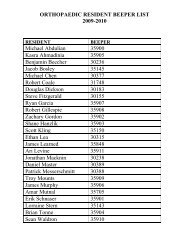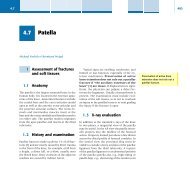Fixation with a Cannulated Screw Displaced Scaphoid Fractures ...
Fixation with a Cannulated Screw Displaced Scaphoid Fractures ...
Fixation with a Cannulated Screw Displaced Scaphoid Fractures ...
Create successful ePaper yourself
Turn your PDF publications into a flip-book with our unique Google optimized e-Paper software.
DISPLACED SCAPHOID FRACTURES TREATED WITH OPEN REDUCTION AND INTERNAL FIXATION 635FIG. 2Illustration showing the technique for measuring scaphoid angulation in the lateral plane. Normal values average 24 degrees. (Reprinted<strong>with</strong> permission of the Mayo Foundation.)agreement <strong>with</strong> the measurements in other reports 18,25 .Sixteen of the nineteen patients in Group 1 and thirteenof the sixteen patients in Group 2 had sagittal andcoronal computerized tomography scans to evaluate thedisplacement of the fracture preoperatively. Postoperativeradiographs were made at monthly follow-up examinations.Once trabecular bridging was suspected on thebasis of radiographs, computerized tomography scanswere made <strong>with</strong> 0.5-millimeter nonreconstructed cuts inthe sagittal and coronal planes.The placement of the screw was assessed on the finalfollow-up anteroposterior radiographs made <strong>with</strong> thewrist in the neutral position and ulnar deviation and onlateral and oblique radiographs made <strong>with</strong> the forearmin pronation and supination 2 . The proximal pole of thescaphoid was divided into three equal sections, <strong>with</strong> themiddle section representing the central one-third. Thescrew was considered to be centrally placed if it waslocated in the central one-third of the proximal pole ofthe scaphoid 25 (Figs. 5 and 6). If the screw extended outof the central one-third of the scaphoid on a single radiograph,it was considered to be peripherally placed.Radiographic measurements were made in a blindedfashion by four orthopaedic surgeons and one plasticsurgeryresident, and the final determination was arrivedat by consensus.The range of motion, grip strength, and pain werealso measured at the final follow-up evaluation. Twentysixpatients were interviewed by an examiner who wasblinded to the type of internal fixation that had beenused. Nine patients were examined by local therapistsand interviewed by one of us by telephone. The range ofmotion was reported as both an absolute measurementand as a percentage of that on the contralateral side.Flexion and extension of the wrist as well as radial andulnar deviation were measured on both the injured andthe contralateral side 10 . Maximum grip strength on theinjured side was measured <strong>with</strong> a Jamar dynamometer(J. P. Marsh, Skokie, Illinois) and was reported as apercentage of the maximum strength on the contralateralside. With the use of a questionnaire, pain was assessedpreoperatively and postoperatively as stage 0 (nopain), stage 1 (mild discomfort or pain that does notrestrict work or sports activities), or stage 2 (pain thatrestricts work or sports activities). The patients werefollowed monthly until the fracture had united and theyhad resumed full activity. They were then followed onan annual basis. All physical and radiographic measurementswere performed at the final follow-up evaluationfor the purposes of this study only.The final follow-up radiographs were examined tograde postoperative osteoarthritis as stage 0 (none),FIG. 3Illustration showing the technique for measuring scaphoid angulationin the anteroposterior plane. Normal values average 45 degrees.(Reprinted <strong>with</strong> permission of the Mayo Foundation.)VOL. 82-A, NO. 5, MAY 2000



